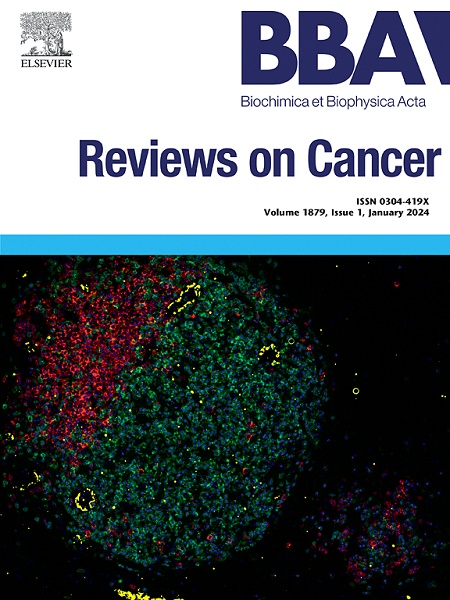Emerging importance of m6A modification in liver cancer and its potential therapeutic role
IF 9.7
1区 医学
Q1 BIOCHEMISTRY & MOLECULAR BIOLOGY
Biochimica et biophysica acta. Reviews on cancer
Pub Date : 2025-03-13
DOI:10.1016/j.bbcan.2025.189299
引用次数: 0
Abstract
Liver cancer refers to malignant tumors that form in the liver and is usually divided into several types, the most common of which is hepatocellular carcinoma (HCC), which originates in liver cells. Other rare types of liver cancer include intrahepatic cholangiocarcinoma (iCCA). m6A modification is a chemical modification of RNA that usually manifests as the addition of a methyl group to adenine in the RNA molecule to form N6-methyladenosine. This modification exerts a critical role in various biological processes by regulating the metabolism of RNA, affecting gene expression. Recent studies have shown that m6A modification is closely related to the occurrence and development of liver cancer, and m6A regulators can further participate in the pathogenesis of liver cancer by regulating the expression of key genes and the function of specific cells. In this review, we provided an overview of the latest advances in m6A modification in liver cancer research and explored in detail the specific functions of different m6A regulators. Meanwhile, we deeply analyzed the mechanisms and roles of m6A modification in liver cancer, aiming to provide novel insights and references for the search for potential therapeutic targets. Finally, we discussed the prospects and challenges of targeting m6A regulators in liver cancer therapy.
m6A修饰在肝癌中的重要性及其潜在的治疗作用。
肝癌是指在肝脏中形成的恶性肿瘤,通常分为几种类型,其中最常见的是肝细胞癌(HCC),它起源于肝细胞。其他罕见类型的肝癌包括肝内胆管癌(iCCA)。m6A修饰是RNA的一种化学修饰,通常表现为在RNA分子中的腺嘌呤上添加一个甲基,形成n6 -甲基腺苷。这种修饰通过调节RNA的代谢,影响基因的表达,在各种生物过程中发挥关键作用。近期研究表明,m6A修饰与肝癌的发生发展密切相关,m6A调节因子可通过调控关键基因的表达和特异性细胞的功能,进一步参与肝癌的发病过程。本文综述了m6A修饰在肝癌研究中的最新进展,并详细探讨了不同m6A调节因子的具体功能。同时,我们深入分析了m6A修饰在肝癌中的作用机制,旨在为寻找潜在的治疗靶点提供新的见解和参考。最后,我们讨论了靶向m6A调节因子在肝癌治疗中的前景和挑战。
本文章由计算机程序翻译,如有差异,请以英文原文为准。
求助全文
约1分钟内获得全文
求助全文
来源期刊

Biochimica et biophysica acta. Reviews on cancer
医学-生化与分子生物学
CiteScore
17.20
自引率
0.00%
发文量
138
审稿时长
33 days
期刊介绍:
Biochimica et Biophysica Acta (BBA) - Reviews on Cancer encompasses the entirety of cancer biology and biochemistry, emphasizing oncogenes and tumor suppressor genes, growth-related cell cycle control signaling, carcinogenesis mechanisms, cell transformation, immunologic control mechanisms, genetics of human (mammalian) cancer, control of cell proliferation, genetic and molecular control of organismic development, rational anti-tumor drug design. It publishes mini-reviews and full reviews.
 求助内容:
求助内容: 应助结果提醒方式:
应助结果提醒方式:


